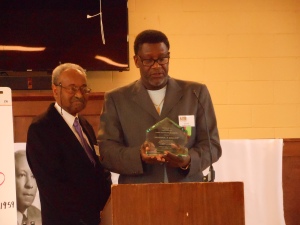Far too many union members and African-Americans today may never have heard of A. Philip Randolph, not realizing the contributions he made both to the civil rights movement and to labor.

WIlliam E. (Bill) Johnson, retired business manager of Laborers Local 113, received the Milwaukee APRI Chapter’s Achievement Award at the event.
Norman Hill, longtime labor and civil rights activist and president emeritus of the A. Philip Randolph Institute, outlined the major legacy that Randolph left upon his death at the age of 90 in 1979. Hill, of Washington, spoke at a program sponsored by the Institute’s Milwaukee Chapter in April to celebrate the 125th Anniversary of Randolph’s birth.
Hill traced Randolph’s life from his founding and leadership of the Sleeping Car Porters Union, the nation’s first predominately black trade union, and his leadership of the union became a springboard that led him to leave a significant mark on the nation’s civil rights and labor history. Randolph brought pressure upon President Franklin D. Roosevelt in 1940 to issue an Executive Order banning discrimination in defense industries, perhaps the first significant action by the federal government to end such practices.
Randolph today is best known for developing – along with Bayard Rustin – the famed 1963 March on Washington, where Dr. Martin Luther King, Jr. made his memorable “I Have a Dream” speech. Hill recalled that President John F. Kennedy at first opposed the March, fearing it would become violent and create a backlash against the civil rights movement. Hill said Randolph persisted and the March was held, its eventual success made possible by the inclusion in the program of both African-American and white leaders, particularly from the labor movement.
The Civil Rights Act of 1964, he said, did not originally contain a job discrimination clause, and it was eventually included when Randolph persuaded AFL-CIO President George Meany to push for it. The clause banned racial discrimination by both companies and labor unions, with Meany urging it cover unions, many of which then practiced discriminatory behavior and needed to “clean up their own act.”
Randolph believed that blacks would never be able to gain equality unless they got involved in politics. He constantly called for blacks to engage in building coalitions with whites, “since whites were also affected by economic issues,” Hill said. In 1965, Randolph founded the Institute that bears his name, settings its three main goals to promote voter participation, get black workers active within their unions and to establish a positive labor presence in the community
Thus the Institute provides a link between labor and the civil rights movement, Hill said.
He stressed the importance of engaging in political activity by outlining the anti-worker and anti-civil rights actions that were occurred under four U.S. Presidents that were elected without the support of organized labor. Under Richard Nixon, he said, the Republicans “southern strategy” was created, a movement that called for a “law and order” agenda that were code words against civil rights. President Reagan opposed both the voting rights and civil rights acts through appointments of administrators that stifled enforcement and gave a permanent blow to labor by firing the striking air traffic controllers in 1981.
Both Bushes, Geroge H. W. and George W., followed similar policies of appointing anti-worker persons to the Supreme Court or key commissions.
Hill said experiences under such Presidents show the need for becoming more active in political action.
Coalition-building is a vital goal to success, he said, urging the involvement of youth and reaching out to other community groups, including all of the civil rights groups of all minorities, including Hispanics, seniors, gay and other progressive organizations. In that way, Hill concluded, today’s activists will “fulfill the legacy of A. Philip Randolph and Bayard Rustin.
